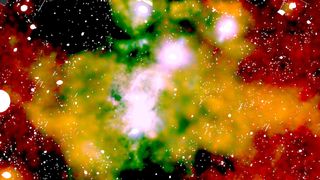The most elusive black holes in the universe could lurk at the Milky Way's center
Astronomers have a plan for using ripples in space-time to hunt for elusive intermediate-mass black holes around the Milky Way's center.

The most elusive black holes in the universe aren't the big ones, or the small ones. They're the medium ones — and a team of astronomers has proposed a new method, using ripples in space-time, to hunt for them.
Known black holes come in two general varieties. There are the stellar-mass black holes, which range from a few to a few dozen times the mass of the sun. And then there are the supermassive black holes, which range in mass from a million suns all the way up to 50 billion solar masses.
Astronomers theorize that there might be some black holes caught in between these two extremes, known as intermediate-mass black holes (IMBHs), with masses a few thousand times that of the sun. But there's one catch: Despite searching for them for decades, we haven't found any yet. And so a team of astronomers, writing on the preprint server arXiv.org (opens in new tab), has proposed a new method to go hunting for IMBHs, using the subtle ripples in space-time caused by the black holes' motions through the center of the Milky Way.
Astronomers desperately want to find an IMBH because it will help them piece together the formation history of black holes. As far as we currently understand it, giant black holes weren't born that way. Instead, they started out as mere stellar-mass black holes. Then, over hundreds of millions of years, they wolfed down any scrap of material that wandered too close, and they also found each other and merged, rapidly ballooning into their impressive current size. That rapid growth suggests that there ought to be few IMBHs left, because that size of black hole represents only a temporary phase on a black hole's way to supermassiveness.

However, other models of black hole formation suggest that IMBHs might actually be common and just difficult to detect. The cramped conditions of the galactic core, for example, might be ripe to produce potentially thousands of large-but-not-supermassive black holes. But those IMBHs might be hidden, as the supermassive black hole in the very center of the galaxy would dominate our observations.
To tease these possibilities out, the authors of the new study hope to use the Laser Interferometer Space Antenna (LISA), a planned gravitational wave detector that the European Space Agency hopes to launch in 2037. The observatory will detect gravitational waves, which are subtle ripples in space-time first predicted by Einstein, as they wash through the solar system. Similar ground-based observatories like the Laser Interferometer Gravitational-Wave Observatory (LIGO) and Virgo have already had tremendous success in detecting mergers of stellar-mass black holes, but those instruments are not sensitive to the frequencies needed to detect signals from anything larger.
LISA will consist of a trio of satellites orbiting the sun that will constantly monitor the distances among them. When a gravitational wave comes by, the satellites will detect the telltale signature, like buoys in the ocean recognizing a passing tidal wave.
To search for IMBHs, the astronomers have to hope for a lucky break. If an IMBH in the galactic center happens to capture a wandering dense remnant (like a smaller black hole, a neutron star, or a white dwarf), the process will emit gravitational waves that LISA can potentially detect. Because the IMBH itself will be orbiting around the central supermassive black hole, these gravitational waves will undergo a Doppler shift (like the shifting in frequencies from a passing ambulance) due to the IMBH's motion.
If enough IMBHs lurk in our galactic core, then these silent acts of destruction may leave delicate signatures in gravitational waves. The proposed method is far from complete, however: LISA will only be able to detect IMBHs if they have a mass range from 1,000 to 100,000 solar masses. It's a longshot to be sure, but it just might work.
Live Science newsletter
Stay up to date on the latest science news by signing up for our Essentials newsletter.

Paul M. Sutter is a research professor in astrophysics at SUNY Stony Brook University and the Flatiron Institute in New York City. He regularly appears on TV and podcasts, including "Ask a Spaceman." He is the author of two books, "Your Place in the Universe" and "How to Die in Space," and is a regular contributor to Space.com, Live Science, and more. Paul received his PhD in Physics from the University of Illinois at Urbana-Champaign in 2011, and spent three years at the Paris Institute of Astrophysics, followed by a research fellowship in Trieste, Italy.
Most Popular

By Harry Baker